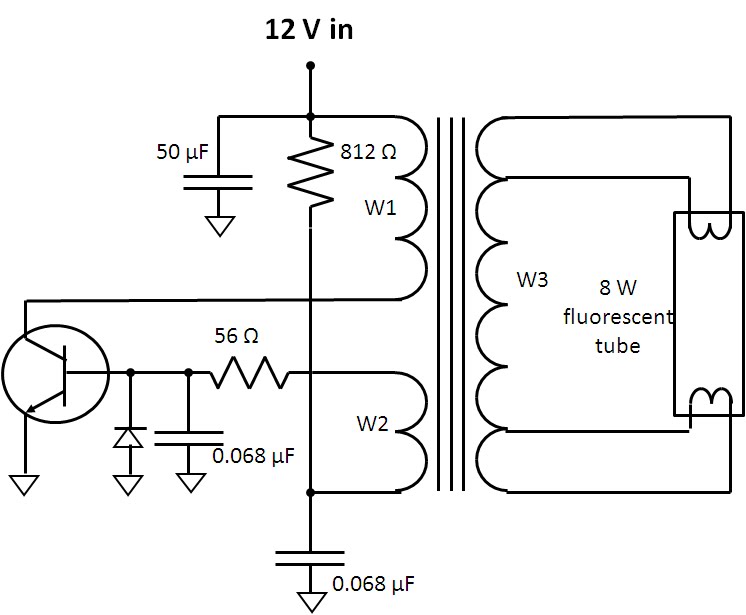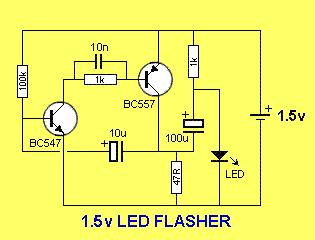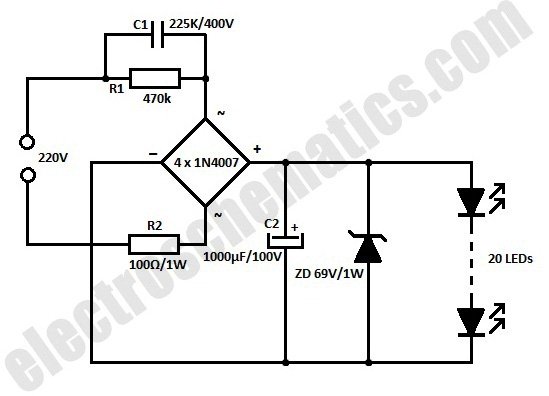
Dark-activated LED or Lamp Flasher

This circuit adopts the rather unusual Bowes/White emitter coupled multivibrator circuit. The oscillation frequency is about 1Hz and is set by C1 value. The LED starts flashing when the photo resistor is scarcely illuminated. The onset of flashing can be set by trimming R2. More: Best results in flashing frequency can be obtained using for C1 a value in the 100 - 1000µF range. To drive a filament lamp make the following changes: Use a 2.2 to 3V, 250-300mA bulb in place of the LED R2 = 10K 1/2W T.
The described circuit utilizes a Bowes/White emitter-coupled multivibrator configuration, which is known for its ability to produce stable oscillations with minimal components. This circuit operates at an oscillation frequency of approximately 1Hz, primarily determined by the capacitance value of capacitor C1. The choice of C1 is critical, as values in the range of 100µF to 1000µF yield optimal performance for the desired flashing frequency.
The circuit includes a photoresistor, which plays a crucial role in controlling the flashing of the LED. When the ambient light level is low, the resistance of the photoresistor increases, allowing the circuit to trigger the LED to flash. The timing and sensitivity of this response can be fine-tuned using resistor R2, which acts as a variable resistor. Adjusting R2 modifies the threshold at which the LED begins to flash, providing flexibility in the circuit’s operation under varying light conditions.
For applications requiring a filament lamp instead of an LED, modifications to the circuit are necessary. A bulb rated between 2.2V and 3V with a current rating of 250-300mA should be used in place of the LED. Additionally, R2 should be replaced with a 10KΩ, 1/2W resistor to accommodate the higher current demands of the filament lamp while maintaining the desired flashing characteristics.
Overall, this circuit offers a simple yet effective solution for creating a flashing light effect in response to ambient light levels, suitable for various applications in visual signaling or decorative lighting. The use of common electronic components makes it accessible for hobbyists and professionals alike.This circuit adopts the rather unusual Bowes/White emitter coupled multivibrator circuit. The oscillation frequency is about 1Hz and is set by C1 value. The LED starts flashing when the photo resistor is scarcely illuminated. The onset of flashing can be set by trimming R2. * Best results in flashing frequency can be obtained using for C1 a value in the 100 - 1000µF range. * To drive a filament lamp make the following changes: Use a 2.2 to 3V, 250-300mA bulb in place of the LED R2 = 10K 1/2W T 🔗 External reference
The described circuit utilizes a Bowes/White emitter-coupled multivibrator configuration, which is known for its ability to produce stable oscillations with minimal components. This circuit operates at an oscillation frequency of approximately 1Hz, primarily determined by the capacitance value of capacitor C1. The choice of C1 is critical, as values in the range of 100µF to 1000µF yield optimal performance for the desired flashing frequency.
The circuit includes a photoresistor, which plays a crucial role in controlling the flashing of the LED. When the ambient light level is low, the resistance of the photoresistor increases, allowing the circuit to trigger the LED to flash. The timing and sensitivity of this response can be fine-tuned using resistor R2, which acts as a variable resistor. Adjusting R2 modifies the threshold at which the LED begins to flash, providing flexibility in the circuit’s operation under varying light conditions.
For applications requiring a filament lamp instead of an LED, modifications to the circuit are necessary. A bulb rated between 2.2V and 3V with a current rating of 250-300mA should be used in place of the LED. Additionally, R2 should be replaced with a 10KΩ, 1/2W resistor to accommodate the higher current demands of the filament lamp while maintaining the desired flashing characteristics.
Overall, this circuit offers a simple yet effective solution for creating a flashing light effect in response to ambient light levels, suitable for various applications in visual signaling or decorative lighting. The use of common electronic components makes it accessible for hobbyists and professionals alike.This circuit adopts the rather unusual Bowes/White emitter coupled multivibrator circuit. The oscillation frequency is about 1Hz and is set by C1 value. The LED starts flashing when the photo resistor is scarcely illuminated. The onset of flashing can be set by trimming R2. * Best results in flashing frequency can be obtained using for C1 a value in the 100 - 1000µF range. * To drive a filament lamp make the following changes: Use a 2.2 to 3V, 250-300mA bulb in place of the LED R2 = 10K 1/2W T 🔗 External reference





